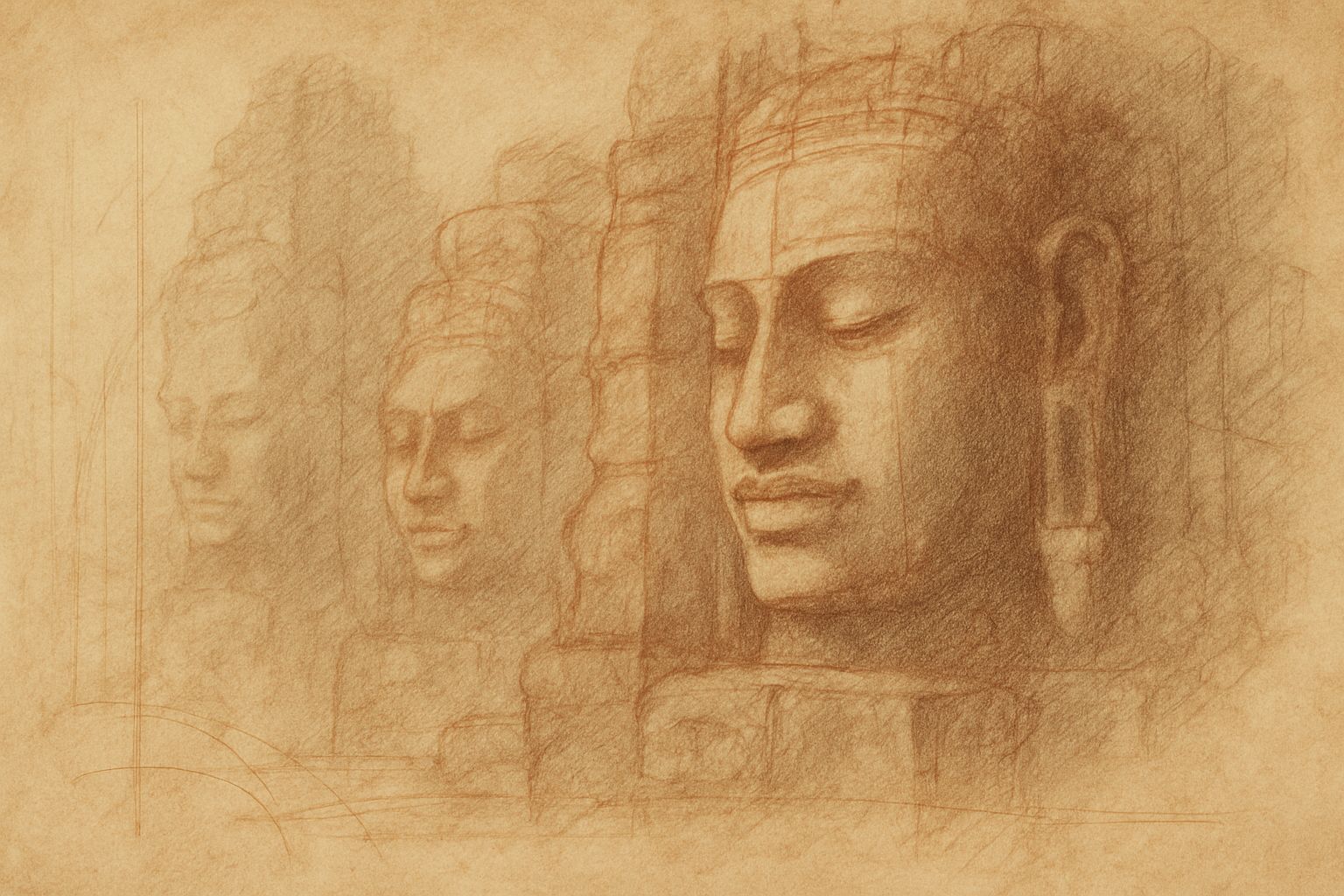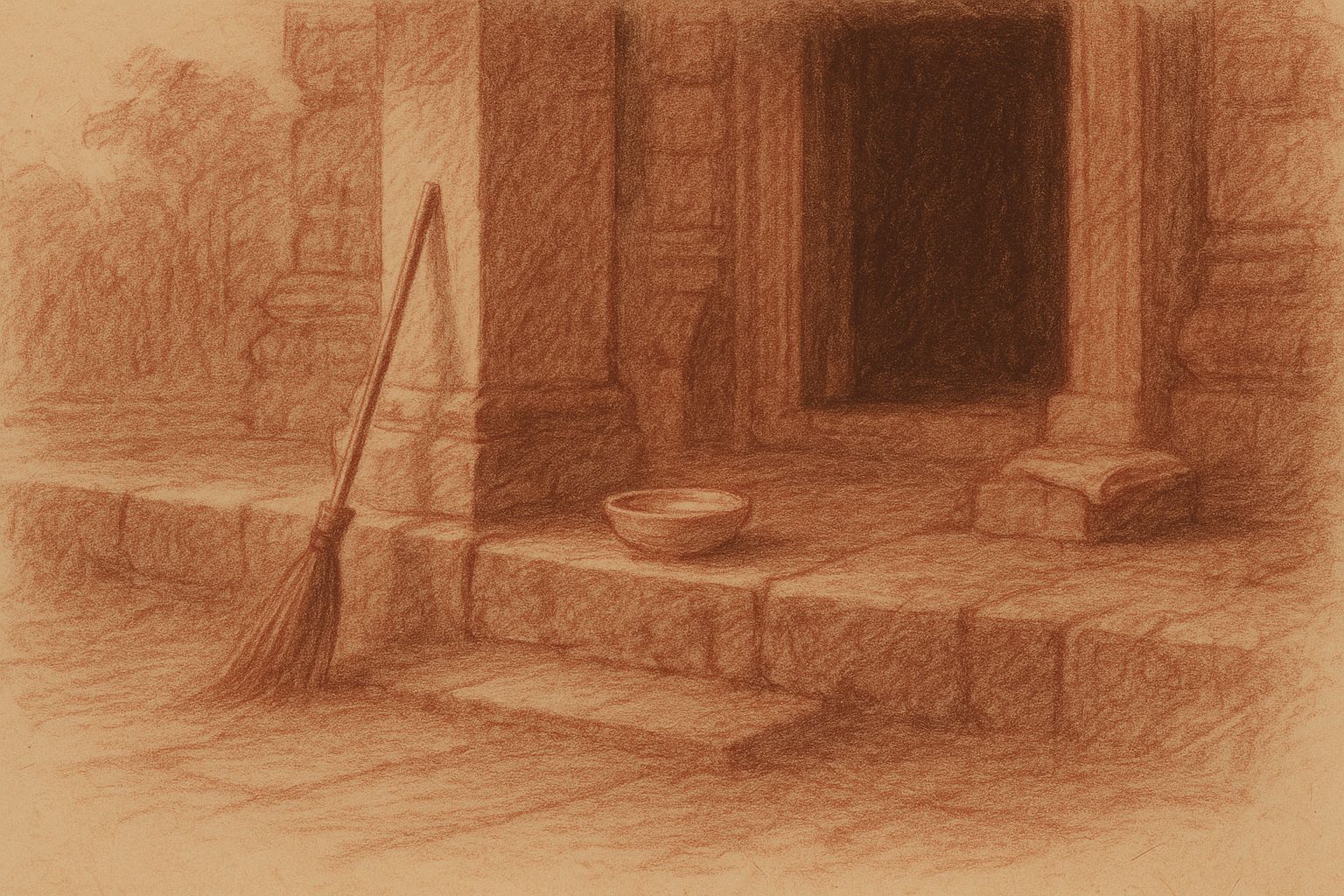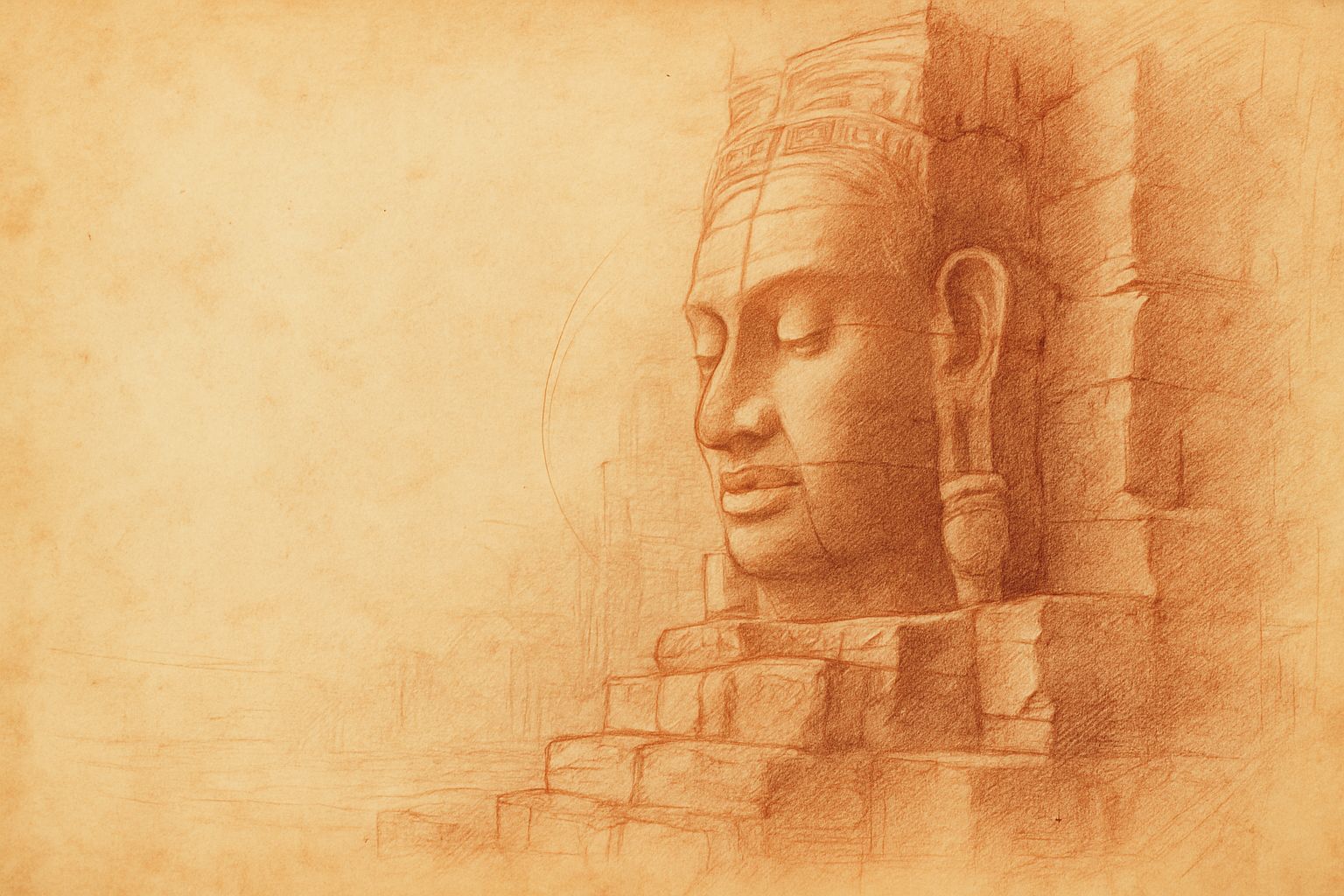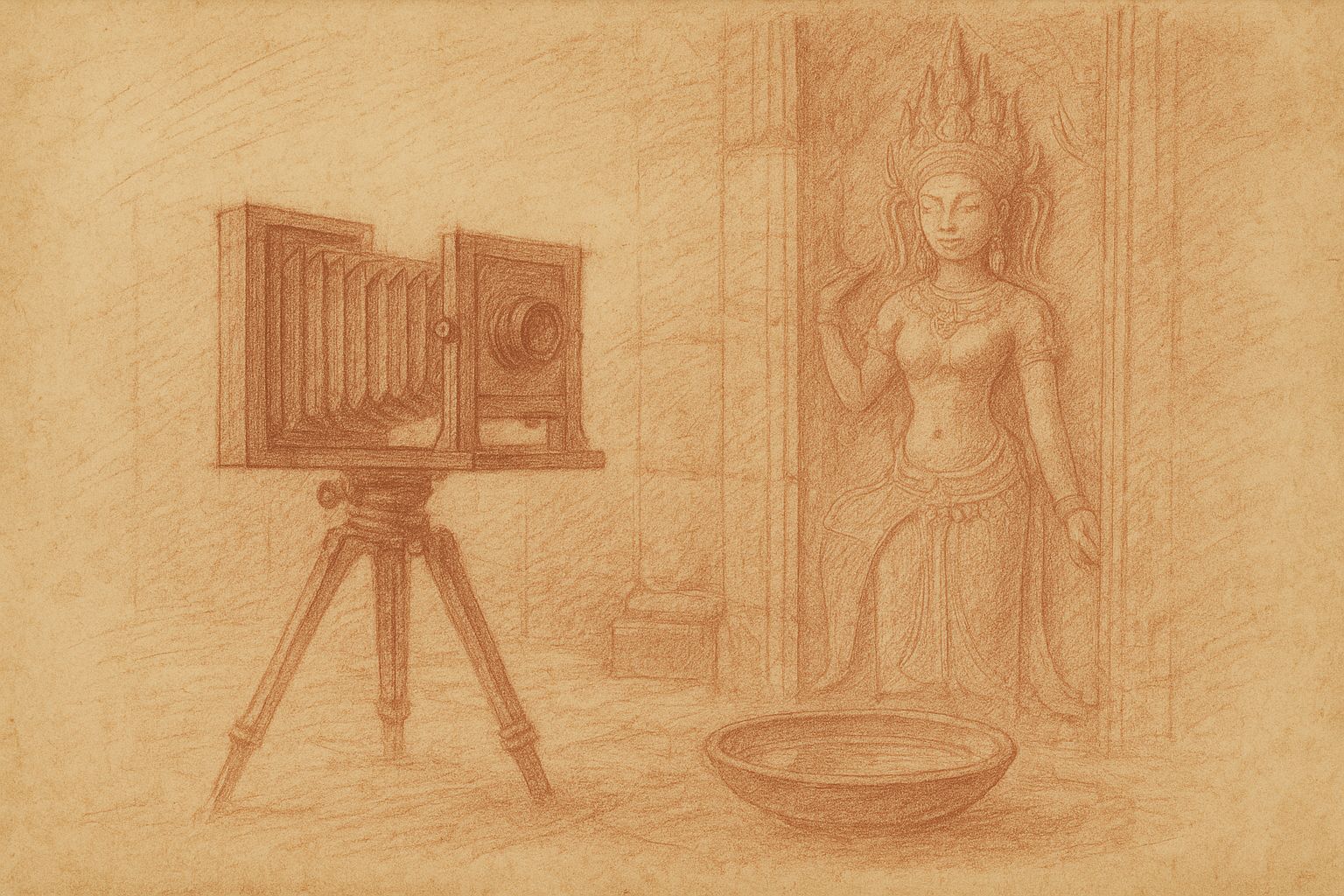Complimentary worldwide shipping on orders over $400 · No import tariffs for most countries
Complimentary worldwide shipping on orders over $400 · No import tariffs for most countries

Stone That Dreams
Faces of Bayon and the Inner Practice of Seeing
Sometimes a face is only stone.
Sometimes it is a mirror waiting for breath.
Dawn lies softly across Bayon, as though the light itself were gathering the courage to enter the forest of towers. I stand beneath the eastern gopura, the air still cool from the night, and feel the hush that settles here before the first pilgrims arrive. It is not silence, exactly—more a listening. A quiet that seems to lean toward the world.
The path leads me inward through shadow, and the towers rise like thoughts forming in the half-light. From afar they seem abstract, almost drifting, but as I move closer the faces surface—serene, watchful, gentle beyond intention. Each one appears to greet the morning in its own rhythm. Each one seems to recognise something I have not yet named.
I have walked among these towers countless times, yet the feeling never diminishes: Bayon is not merely a temple but a mind made visible. A mind turning slowly across centuries, dreaming in stone. The closer I look, the more the faces multiply—not only across the towers, but within my own shifting perception. I see them, and I see the part of me that is doing the seeing.
It is easy, from a distance, to mistake the faces for repetition—forty-nine towers crowned by identical calm. But up close they diverge. A slight tilt of the mouth, a softer lift of the eyelid, the faint thread of compassion or a subtle note of resolve. This is not duplication. It is intention carried through variation.
A pavilion pillar catches the early light, and for a moment the carved lips seem to breathe. I step back, and the expression changes again. There is strangeness in this—a recognition that what I witness is shaped by angle, luminance, humidity, and the state of my own breath. These faces offer their first lesson with quiet certainty: perception is forever plural.
I move into the central sanctuary, where the stone has settled into a deeper dusk. Incense hangs in slow curls near the threshold, softening every edge it touches. The labyrinth folds and refolds around me, and now the faces appear in dimmer registers, half-seen, nearly imagined. In this shadowed light they become less expression than presence.
A paradox emerges. Each face is unmistakably human—recognisably calm, recognisably benevolent—yet also more-than-human, as though the sculptors were distilling qualities rather than reproducing portraits. The lips do not smile; they hold patience. The eyes do not simply look; they offer steadiness. It is a kind of human that exists where memory and aspiration meet.
People often ask who these faces represent: Avalokiteshvara, Lokeshvara, the bodhisattva kings—Jayavarman VII’s empathy made manifest. Yet standing here, the names feel secondary to the intention: compassion raised into stone and multiplied across the horizon. The temple becomes a three-dimensional mandala of awareness, a geometry of qualities set in tower height.
The longer I stay, the more the multiplicity becomes its own form of instruction. I realise I am not moving through a forest of uniform guardians but through a field of inner states—moments of clarity, gestures of patience, small movements of mercy—each carved with deliberate care. Something in me steadies at that recognition. I do not need them to be one; it is enough that they are many.
A breeze threads through the corridor, carrying the scent of old leaves. Its movement stirs a hollow resonance in the stone, reminding me that these towers were meant to be listened to. Bayon is not static. It is porous, full of thresholds where light pools, full of apertures where sound lingers, full of turns where a single breath becomes a quiet act of devotion. I exhale, and the air seems to meet me halfway.
Outside, the faces turn toward every cardinal point, gazing across forest, moat, and distant village. Their orientation is intentional: compassion facing outward in all directions. It is a gesture of responsibility, a reminder that whatever steadiness we uncover inwardly must travel beyond ourselves. Architecture becomes ethic.
When I look up at the highest tower, the morning has warmed into a gentler gold. The face above me shifts again, though nothing has changed except the sun. It is a moment I have encountered countless times yet feel anew each day: the realisation that inner multiplicity is not disorder but richness. That the self, like Bayon, holds many quiet strands in balance.
I place my hand on the stone. It is warm now, carrying centuries of light held and released. I close my eyes and feel a presence behind the carved serenity—not mystical, not distant, but steady and near, like a hand resting through time. A thought rises with unexpected tenderness: if the mind can shelter so many selves, perhaps it can also show mercy to each one.
Somewhere between breath and stillness, I understand why these faces have endured with such authority. They do not instruct. They invite. They offer the subtle reassurance that to be human is to be plural, and to be plural is to deepen rather than fracture. In the mirror of their calm, something within me aligns.
When I leave by the western gate, the faces accompany me in a gentle turning, shifting with the angle of light. I glance back once more, and the features seem to gather into a single, quiet coherence. Not unity, but harmony. Not sameness, but a rhythm shaped by many selves at rest.
The temple dreams on. And perhaps, beneath the surface of my own breath, so do I.
Also in Library

Those Who Keep the Way Open — On the Quiet Guardians of Angkor’s Thresholds
3 min read
Quiet gestures shape the way into Angkor — a swept stone, a refilled bowl, a hand steadying a guardian lion. This essay reflects on the unseen custodians whose daily care keeps the thresholds open, revealing how sacredness endures not through stone alone, but through those who tend its meaning.

Multiplicity and Mercy — The Face Towers of Jayavarman VII
5 min read
A new vision of kingship rises at the Bayon: serene faces turned to every horizon, shaping a world where authority is expressed as care. Moving through the terraces, one enters a field of steady, compassionate presence — a landscape where stone, light, and time teach through quiet attention.

The Still Eye — Craft, Meditation, and the Listening Camera
4 min read
In the darkroom, silver begins to breathe—and a morning at Bayon returns. The essay moves from tray to temple and back, tightening its centre around a single vow: consent, not capture. A butterfly’s tremor, a lintel at dawn, a print clearing in water. Craft becomes meditation; the camera, a quiet bowl for light.
Join My Studio Journal
Receive occasional letters from my studio in Siem Reap—offering a glimpse into my creative process, early access to new fine art prints, field notes from the temples of Angkor, exhibition announcements, and reflections on beauty, impermanence, and the spirit of place.
No noise. No clutter. Just quiet inspiration, delivered gently.
Subscribe and stay connected to the unfolding story.

Join My Studio Journal
Receive occasional letters from my studio in Siem Reap—offering a glimpse into my creative process, early access to new fine art prints, field notes from the temples of Angkor, exhibition announcements, and reflections on beauty, impermanence, and the spirit of place.
No noise. No clutter. Just quiet inspiration, delivered gently.
Subscribe and stay connected to the unfolding story.
